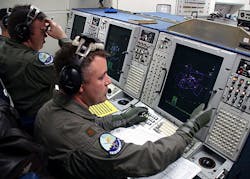Lockheed Martin to design full-up prototype decision aids to plan complex aerial warfare
Officials of the U.S. Air Force Research Laboratory Information Directorate in Rome, N.Y., announced a $16.2 million contract Monday to the Lockheed Martin (NYSE:LMT) Aeronautics segment in Fort Worth, Texas, for phase-two of the Distributed Battle Management (DBM) program, which seeks to develop flexible planning software for aircraft onboard systems.
The contract calls for Lockheed Martin to develop an integrated distributed battle management capability to manage air-to-air and air-to-ground combat in a peer threat-contested environment, Air Force officials say.
The Air Force Research Lab is awarding the contract on behalf of the U.S. Defense Advanced Research Projects Agency (DARPA) in Arlington, Va. Lockheed Martin Aeronautics also manufactures the F-35 Lightning II joint strike fighter.
DBM planning tools would help U.S. and allied aircraft avoid threats and attack targets in the presence of jamming or other countermeasures that limit the abilities of communications and sensor networks against large and formidable threats.
Related: Lockheed Martin to develop open-systems software to enhance Air Force mission planning
The DBM decision aids will be integrated into on-board software and will help airborne battle managers and pilots maintain situational awareness, recommend tasks, generate detailed fighting plans, and keep control of the fight, DARPA officials say.
DARPA scientists say they believe current research has matured sufficiently to choose algorithms to meet the needs for airborne battle decision aids.
Consider an air-to-air mission with a Navy E-2D battle management aircraft, an unmanned aerial vehicle (UAV) with infrared search and track (IRST) capability, several F-35 strike fighters, and weapons. Focus on one target, and assume limited communications without tactical data links or SATCOM, and ineffective surveillance radar due to jamming.
In these conditions planners could rely on other sensors, other data routing, and other decision makers than what they're used to. Planners could rely on the UAV's infrared sensors and communications relays to protect aircraft and find targets, DARPA researchers say.
If the UAV sensors detect a target, the E-2D's DBM tools could fuse the data to geolocate, identify, and track the targets. The DBM tools, furthermore, could lay out several options ranked by risk and likelihood of success. Orders to available attack aircraft could flow through the E-2D and perhaps even the UAV.
When the problem scales to a realistic threat with hundreds or thousands of targets, DBM might manage manned and unmanned aircraft teams for weapons, sensors, and jamming, DARPA researchers say.
The challenge for the DBM program is to build new algorithms that are reliable against realistic threats, including, integrating the software onto real aircraft, and demonstrating it in simulated combat.
The first phase of the DARPA DBM program focused on developing algorithms and human-machine interfaces. In the second phase Lockheed Martin experts will design full-up prototype software DBM decision aids and demonstrate them in large-scale simulations and live-fly events.
For more information contact Lockheed Martin Aeronautics online at www.lockheedmartin.com/us/aeronautics" rel="nofollow" target="_blank">www.lockheedmartin.com/us/aeronautics, the Air Force Research Laboratory Information Directorate at www.wpafb.af.mil/afrl/ri, or DARPA at www.darpa.mil.
